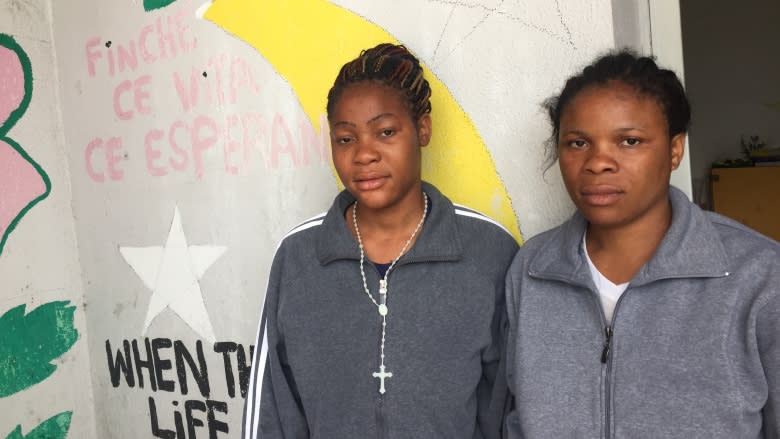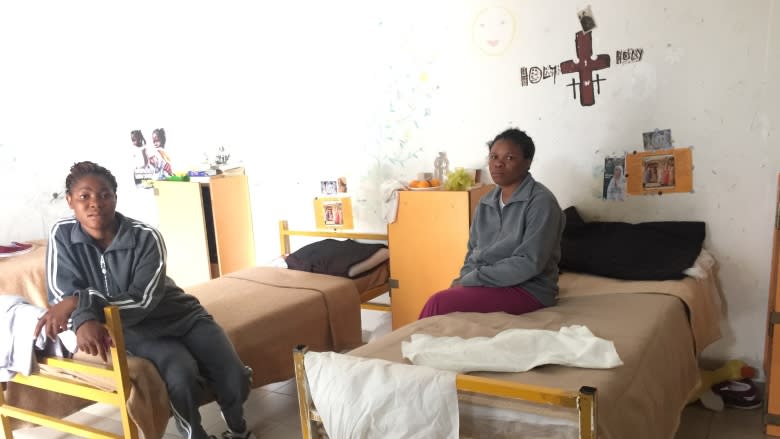Not-quite freedom: After harrowing crossing, migrants forced into waiting game in Italy's detention camps
When Favour Osaheroumwea, 21, fled her home in Nigeria last summer, she had dreams of becoming a nurse in Europe.
She knew the journey would be tough. What she did not expect, after surviving it, was to end up in a bleak prison on a side road near Rome's main airport, waiting to hear if she could stay in Italy.
Sitting with a friend at a steel table in the caged courtyard of the Ponte Galeria Identification and Expulsion Centre, she shares her story in a near-whisper.
First, she says, she survived the exhausting journey across the Sahara Desert to Libya, drinking tepid water scooped from an abandoned well with a decomposing body in it.
Then came four months of repeated beatings, rapes and sexual slavery at the hands of human traffickers — the network of men who control the migration routes up through Central Africa, into Libya, and onto the boats they cram with people hoping for a better life in Europe.
"They would burst into this house and point to you with a gun," Osaheroumwea says, referring to the crammed compound where she and several hundred other migrants were held, awaiting their chance to cross the Mediterranean.
"One day a week, two days — if you don't allow them to rape you, they will shoot you. So you don't have a choice."
The rate at which asylum-seekers are being rescued in the Mediterranean Sea is on the rise, with 30 per cent more people being brought to Italy in the first few months of 2017 compared to the same period last year, when a record total of 181,000 arrived.
This week, Italy gave four repaired boats to the Libyan Coast Guard as part of an EU-backed pledge of millions of dollars in training and supplies, aimed at helping the Libyans stop boatloads of people from leaving their shores.
But humanitarian groups say the Libyan rescuers, controlled by trafficking gangs, only deliver the migrants — like the women in Ponte Galeria — back into the hands of the smugglers and the cycle of abuse.
Beside Osaheroumwea sits 22-year-old Joy Ese, also from Nigeria. Ese says she, too, was repeatedly raped by the traffickers.
"One would hold your arms, the other would hold your legs, the other would use you. After that one, another one. Then they would say, 'Go,'" she says.
If that weren't enough, the female captives were often forced into prostitution to pay for food and shelter.
"There's a place they used to call 'Connection House,'" says Osaheroumwea. "We go there for the night and do prostitution."
"You need to work with your body to get food to eat," adds Ese.
After months of abuse, each woman paid several hundred dollars to be "pushed into a boat," as Ese puts it, to make the dangerous crossing toward Italy. So far this year, close to 1,500 people have died trying to make it here.
While the refugees risk their lives at sea, it's often the legacy of abuse they endure in the hands of the traffickers in Libya that causes the most trauma.
Yet instead of help, the 63 young women at this centre face the fear of being repatriated, and long, monotonous days, as they await the outcome of their asylum claims.
"If the people inside these centres posed a risk to the Italian state, then that's one thing," says Senator Luigi Manconi, of Italy's ruling Democratic Party, a strong critic of the expulsion centres.
"But what's the sense of keeping women who are victims of trafficking here? Should they not instead be in protected, anonymous centres with psychologists and social workers who help them denounce their exploiters?"
Not only are the camps inhumane, Manconi says, but they have a track record of failure, with only half of the inmates being properly identified. And insufficient agreements with the migrants' countries of origin make it difficult to send people back.
But as Italy moves to hasten the rate of deportations, part of a pledge made late last year, when the country vowed a tougher stance on illegal crossings, Interior Minister Marco Minniti has announced plans to open new identification and expulsion centres, including a men's section at Ponte Galeria.
(The camp previously had one, but it was shuttered two years ago, when inmates sewed their mouths shut in protest, then set fire to it.)
Manconi says the centres — which the government had initially begun to phase out a few years ago — should be closed entirely. "If you can't stop people coming here, then you have to work to stop the sexual slavery," he says.
Meanwhile, the women inside Ponte Galeria continue to wait.
"Me, I'm six months here now," says Violet, another woman from Nigeria, who did not want to give her last name.
"I did not do anything. I did not kill anybody. I am not on the road, working. No prostitution.
"We want freedom."



